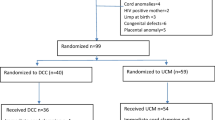Abstract
Objective
To determine elective induction of labor outcomes in term, low-risk women who delivered in a community teaching hospital.
Methods
This is a retrospective cohort study of women admitted from January 1, 2006 to January 31, 2010, for elective induction of labor. A comprehensive search of the perinatal database identified low-risk patients at ≥39 weeks gestation and ≤41 weeks with singleton pregnancies in vertex presentation. Data abstracted from manual chart review included patient demographics, admission cervical examination, and induction method. Outcome measures were delivery method and cesarean indications. Time categories calculated were mean times from induction to delivery, delivery to discharge, and total hospital length-of-stay. Descriptive statistics, frequencies, and percentages were reported using multiple regression analysis, analysis of variance, and effect tests with respective values reported. Data were analyzed using JMP software by SAS Institute Inc.
Results
Of the 1,159 women identified, 848 records passed exclusion criteria. Vaginal delivery was accomplished for 694 (81.8 %) of patients. The most common induction agent was oxytocin (73.7 %). Induction of labor with oxytocin and artificial rupture of membranes revealed a statistically significant shorter length of induction with average induction of labor for oxytocin of 11.9 h. Multiparous patients of parity >1 and patients presenting with cervical dilation of 3–4 cm had a statistically significant higher probability of vaginal delivery. Patients induced with a foley bulb or dinoprostone had statistically longer induction times (28.2 and 24.9 h, respectively) and had a statistically significant higher probability of cesarean delivery.
Conclusion
Multiparous patients and patients with a favorable cervix (>2 cm) were more likely to have a vaginal delivery and shorter length of induction.
Similar content being viewed by others
References
Crane JM (2006) Factors predicting labor induction success: a critical analysis. Clin Obstet Gynecol 49:573–581
Beebe LA, Rayburn WF, Beaty CM, Eberly KL, Stanley JR, Rayburn LA (2000) Indications for labor induction. Differences between university and community hospitals. J Reprod Med 45(6):469–475
Rayburn W, Zhang J (2002) Rising rates of labor induction: present concerns and future strategies. Obstet Gynecol 100:164–167
Clark SL, Miller DD, Belfort MA et al (2009) Neonatal and maternal outcomes associated with elective term delivery. Am J Obstet Gynecol 200:156–158
Vrouenraets FP, Roumen FJ, Dehing CJ et al (2005) Bishop Score and risk of cesarean delivery after induction of labor in nulliparous women. Obstet Gynecol 105:690
Luthy DA, Malmgren JA, Zingheim RW (2004) Cesarean delivery after elective induction in nulliparous women: the physician effect. Am J Obstet Gynecol 191:1511
Baacke KA (2006) Preinduction Cervical Assessment. Clin Obstet Gynecol 49:564–571
Vahratian A, Zhang J, Troendle JF et al (2005) Labor progression and risk of cesarean delivery in electively induced nulliparas. Obstet Gynecol 105:698–704
American College of Obstetricians and Gynecologists (2009) ACOG Practice Bulletin No. 107: induction of labor. Obstet Gynecol 114:386–397
Seyb ST, Berka RJ, Socol ML et al (1999) Risk of cesarean delivery with elective induction of labor at term in nulliparous women. Obstet Gynecol 94:600–607
Zhang J, Yancy MK, Henderson CE (2002) National trends in labor induction, 1989–1998. JRM 47:120–124
Martin JA, Hamilton BE, Sutton PD, Ventura SJ, Menacker F, Kirmeyer S et al (2009) Births: final data for 2006. Natl Vital Stat Rep 57:1–102
Conflict of interest
The authors declare that they have no conflict of interest.
Author information
Authors and Affiliations
Corresponding author
Rights and permissions
About this article
Cite this article
Tam, T., Conte, M., Schuler, H. et al. Delivery outcomes in women undergoing elective labor induction at term. Arch Gynecol Obstet 287, 407–411 (2013). https://doi.org/10.1007/s00404-012-2582-1
Received:
Accepted:
Published:
Issue Date:
DOI: https://doi.org/10.1007/s00404-012-2582-1




